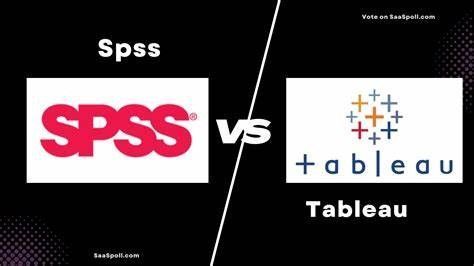
When to Choose SPSS?

Welcome to the world of data analysis, where the power of numbers and statistics holds the key to unlocking valuable insights. In today’s data-driven era, organizations rely on robust analytical tools to make informed decisions and drive growth. Among the numerous options available, two popular choices stand out: SPSS and Tableau. Both tools offer unique features and capabilities that cater to different analytical needs.
The Power of SPSS
IBM SPSS, or Statistical Package for the Social Sciences, has been a leading player in the field of statistical analysis for decades. With its comprehensive set of statistical tools and features, SPSS empowers researchers, data scientists, and analysts to explore and analyze complex datasets. It provides a user-friendly graphical interface that enables users to perform various statistical tests, data visualization, and predictive modeling.
One of the key advantages of SPSS is its wide range of statistical procedures. From basic descriptive statistics to advanced techniques like regression analysis and factor analysis, SPSS offers a plethora of options to investigate relationships, patterns, and trends within your data. Moreover, SPSS allows for seamless integration with other statistical software like R and Python, expanding its analytic capabilities even further.
The Versatility of Tableau
Tableau, on the other hand, is a data visualization tool that has gained immense popularity among data analysts and business intelligence professionals. With its intuitive interface and interactive visualizations, Tableau allows users to explore data in a highly engaging and dynamic manner.
Tableau’s strength lies in its ability to connect to a wide variety of data sources, empowering users to blend, transform, and analyze data from multiple platforms. Whether your data resides in spreadsheets, databases, or cloud-based systems, Tableau makes it easy to integrate and extract meaningful insights.
Use Cases: When to Choose SPSS?
Data Analysis in the Social Sciences
SPSS was initially developed for research purposes in the social sciences. It offers a wide range of statistical procedures specifically designed to analyze social, behavioral, and economic data. Researchers and academics in fields such as psychology, sociology, and economics often turn to SPSS for its specialized statistical tests and algorithms.
SPSS also provides advanced features for survey research, such as data preparation, questionnaire design, and statistical analysis of survey data. Its ability to handle complex survey designs and perform weighted analyses makes it an invaluable tool for researchers working on large-scale survey projects.
Predictive Modeling and Machine Learning
Another area where SPSS excels is predictive modeling and machine learning. With its robust algorithms and model building capabilities, SPSS enables users to develop predictive models that can forecast future outcomes based on historical data. Whether it’s predicting customer churn, forecasting sales, or estimating risk, SPSS offers a range of techniques like regression, decision trees, and neural networks to tackle predictive analytics challenges.
Use Cases: When to Choose Tableau?
Interactive Data Exploration and Reporting
Tableau’s interactive and visually appealing dashboards make it an ideal choice for data exploration and reporting. Whether you need to monitor key performance indicators, track sales trends, or analyze customer behavior, Tableau provides a highly interactive and dynamic environment to explore and understand your data.
Tableau’s drag-and-drop interface allows even non-technical users to create stunning visualizations and reports without writing a single line of code. Its powerful data connectors and real-time updates ensure that your dashboards are always up to date, providing fresh insights on the fly.
Collaborative Business Intelligence
Tableau’s collaborative features make it a preferred choice for organizations looking to foster a data-driven culture. With Tableau’s server and online platforms, users can share dashboards and reports with colleagues, enabling seamless collaboration and knowledge sharing.
Tableau’s collaboration tools also include features like commenting and annotation, allowing users to provide feedback and insights directly within the dashboards. This promotes a collaborative and iterative approach to data analysis, where stakeholders can engage in meaningful discussions and drive collective decision-making.
All Rights Reserved | Genx DMCC